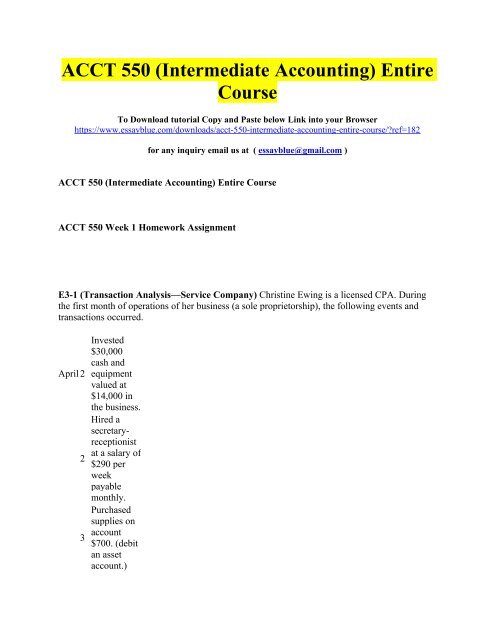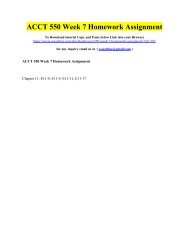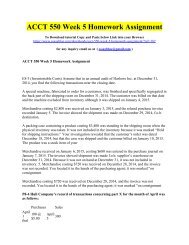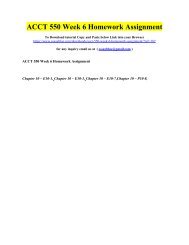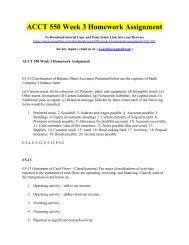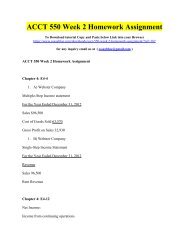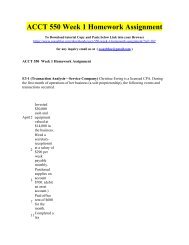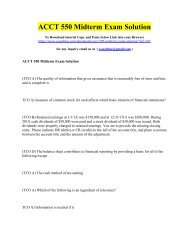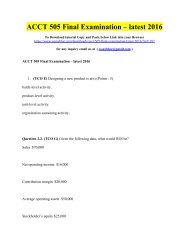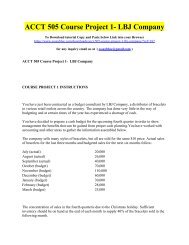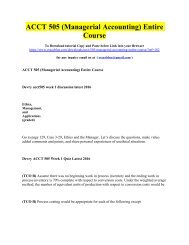ACCT 550 (Intermediate Accounting) Entire Course
ACCT 550 (Intermediate Accounting) Entire Course
ACCT 550 (Intermediate Accounting) Entire Course
You also want an ePaper? Increase the reach of your titles
YUMPU automatically turns print PDFs into web optimized ePapers that Google loves.
<strong>ACCT</strong> <strong>550</strong> (<strong>Intermediate</strong> <strong>Accounting</strong>) <strong>Entire</strong><br />
<strong>Course</strong><br />
To Download tutorial Copy and Paste below Link into your Browser<br />
https://www.essayblue.com/downloads/acct-<strong>550</strong>-intermediate-accounting-entire-course/?ref=182<br />
for any inquiry email us at ( essayblue@gmail.com )<br />
<strong>ACCT</strong> <strong>550</strong> (<strong>Intermediate</strong> <strong>Accounting</strong>) <strong>Entire</strong> <strong>Course</strong><br />
<strong>ACCT</strong> <strong>550</strong> Week 1 Homework Assignment<br />
E3-1 (Transaction Analysis—Service Company) Christine Ewing is a licensed CPA. During<br />
the first month of operations of her business (a sole proprietorship), the following events and<br />
transactions occurred.<br />
April 2<br />
2<br />
3<br />
Invested<br />
$30,000<br />
cash and<br />
equipment<br />
valued at<br />
$14,000 in<br />
the business.<br />
Hired a<br />
secretaryreceptionist<br />
at a salary of<br />
$290 per<br />
week<br />
payable<br />
monthly.<br />
Purchased<br />
supplies on<br />
account<br />
$700. (debit<br />
an asset<br />
account.)
Paid office<br />
rent of $600<br />
7<br />
for the<br />
month.<br />
Completed a<br />
tax<br />
assignment<br />
and billed<br />
client<br />
11 $1,100 for<br />
services<br />
rendered.<br />
(Use Service<br />
Revenue<br />
account.)<br />
Received<br />
$3,200<br />
advance on<br />
12 a<br />
management<br />
consulting<br />
engagement.<br />
Received<br />
cash of<br />
$2,300 for<br />
17 services<br />
completed<br />
for Ferengi<br />
Co.<br />
Paid<br />
insurance<br />
21<br />
expense<br />
$110.<br />
Paid<br />
secretaryreceptionist<br />
30<br />
$1,160 for<br />
the month.<br />
A count of<br />
supplies<br />
indicated<br />
30<br />
that $120 of<br />
supplies had<br />
been used.<br />
30 Purchased a<br />
new
computer<br />
for $5,100<br />
with<br />
personal<br />
funds. (The<br />
computer<br />
will be used<br />
exclusively<br />
for business<br />
purposes.)<br />
E3-5 (Adjusting Entries) The ledger of Chopin Rental Agency on March 31 of the current year<br />
includes the following selected accounts before adjusting entries have been prepared.<br />
Debit Credit<br />
$<br />
3,600<br />
Prepaid<br />
Insurance<br />
Supplies 2,800<br />
Equipment 25,000<br />
Accumulated<br />
Depreciation—<br />
Equipment<br />
$<br />
8,400<br />
Notes Payable 20,000<br />
Unearned Rent<br />
6,300<br />
Revenue<br />
Rent Revenue 60,000<br />
Interest<br />
Expense<br />
Salaries and<br />
Wages<br />
Expense<br />
14,000<br />
An analysis of the accounts shows the following.<br />
<br />
<br />
<br />
The equipment depreciates $250 per month.<br />
One-third of the unearned rent was earned during the quarter.<br />
Interest of $500 is accrued on the notes payable.<br />
Supplies on hand total $650.<br />
<br />
Insurance expires at the rate of $300 per month.
most directly related to measuring the performance and financial status of an enterprise are<br />
provided below.<br />
Assets<br />
Distributions to<br />
Expenses<br />
owners<br />
Liabilities<br />
Comprehensive<br />
Gains<br />
income<br />
Equity Revenues Losses<br />
Investments<br />
by owners<br />
Identify the element or elements associated with the 12 items below.<br />
CA1-3 (Financial Reporting and <strong>Accounting</strong> Standards) Answer the following multiplechoice<br />
questions.<br />
<strong>ACCT</strong> <strong>550</strong> Week 2 Homework Assignment<br />
Chapter 4: E4-4<br />
1. A) Webster Company<br />
Multiple-Step Income statement<br />
For the Year Ended December 31, 2012<br />
Sales $96,500<br />
Cost of Goods Sold 63,570<br />
Gross Profit on Sales 32,930<br />
1. B) Webster Company<br />
Single-Step Income Statement<br />
For the Year Ended December 31, 2012
Revenue<br />
Sales 96,500<br />
Rent Revenue<br />
Chapter 4: E4-12<br />
Net Income:<br />
Income from continuing operations<br />
Before income tax 21,650,000<br />
Income tax (21,650,000 x 35%) 7,577,500<br />
Income from continuing operations 14,072,500<br />
Chapter 4: P4-1<br />
Dickinson Company<br />
Income Statement<br />
For the Year Ended December 31, 2012<br />
<strong>ACCT</strong> <strong>550</strong> Week 3 Homework Assignment<br />
E5-2 (Classification of Balance Sheet Accounts) Presented below are the captions of Faulk<br />
Company’s balance sheet<br />
(a) Current assets. (b) Investments. (c) Property, plant, and equipment. (d) Intangible assets. (e)<br />
Other assets. Instructions (f) Current liabilities. (g) Noncurrent liabilities. (h) Capital stock. (i)<br />
Additional paid-in capital. (j) Retained earnings. Indicate by letter where each of the following<br />
items would be classified.<br />
1. Preferred stock. 2. Goodwill. 3. Salaries and wages payable. 4. Accounts payable. 5.<br />
Buildings. 6. Equity investments (trading). 7. Current maturity of long-term debt. 8.
Premium on bonds payable. 9. Allowance for doubtful accounts. 10. Accounts receivable.<br />
11. Cash surrender value of life insurance. 12. Notes payable (due next year). 13.<br />
Supplies. 14. Common stock. 15. Land. 16. Bond sinking fund. 17. Inventory. 18. Prepaid<br />
insurance. 19. Bonds payable. 20. Income taxes payable<br />
E 5-4, E 5-12, E 5-13, P 5-2<br />
E5-13<br />
E5-13 (Statement of Cash Flows—Classifications) The major classifications of activities<br />
reported in the statement of cash flows are operating, investing, and financing. Classify each of<br />
the transactions listed below as:<br />
1. Operating activity—add to net income.<br />
2. Operating activity—deduct from net income.<br />
3. Investing activity.<br />
4. Financing activity.<br />
5. Reported as significant noncash activity<br />
<strong>ACCT</strong> <strong>550</strong> Week 4 Homework Assignment<br />
E6-5<br />
(Computation<br />
of Present<br />
Value) Using<br />
the<br />
appropriate<br />
interest table,<br />
compute the<br />
present<br />
values<br />
of the<br />
following<br />
periodic
amounts due<br />
at the end of<br />
the<br />
designated<br />
periods.<br />
(a) $30,000<br />
receivable at<br />
the end of<br />
each period<br />
for 8 periods<br />
compounded<br />
at 12%.<br />
This is a case<br />
of annuity<br />
because the<br />
person is<br />
receiving the<br />
amount at the<br />
end of each<br />
period.<br />
E6-12 (Analysis of Alternatives) The Black Knights Inc., a manufacturer of low-sugar, lowsodium,<br />
low-cholesterol TV dinners, would like to increase its market share in the Sunbelt. In<br />
order to do so, Black Knights has decided to locate a new factory in the Panama City area. Black<br />
Knights will either buy or lease a site depending upon which is more advantageous. The site<br />
location committee has narrowed down the available sites to the following three buildings.<br />
Building A: Purchase for a cash price of $600,000, useful life 25 years. Building B: Lease for 25<br />
years with annual lease payments of $69,000 being made at the beginning of the year. Building<br />
C: Purchase for $650,000 cash. This building is larger than needed; however, the excess space<br />
can be sublet for 25 years at a net annual rental of $7,000. Rental payments will be received at<br />
the end of each year. The Black Knights Inc. has no aversion to being a landlord. Instructions In<br />
which building would you recommend that The Black Knights Inc. locate, assuming a 12% cost<br />
of funds?<br />
E7-5 (Recording Sales Gross and Net) On June 3, Arnold Company sold to Chester Company<br />
merchandise having a sale price of $3,000 with terms of 2/10, n/60, f.o.b. shipping point. An<br />
invoice totaling $90, terms n/30, was received by Chester on June 8 from John Booth Transport<br />
Service for the freight cost. On June 12, the company received a check for the balance due from<br />
Chester Company.<br />
Instructions (a) Prepare journal entries on the Arnold Company books to record all the events<br />
noted above under each of the following bases. (1) Sales and receivables are entered at gross<br />
selling price.<br />
(2) Sales and receivables are entered at net of cash discounts. (b) Prepare the journal entry under<br />
basis 2, assuming that Chester Company did not remit payment until July 29
E7-7 (Recording Bad Debts) Duncan Company reports the following financial information<br />
before adjustments. Dr. Cr. Accounts Receivable$100,000 Allowance for Doubtful<br />
Accounts$2,000 Sales (all on credit) 900,000 Sales Returns and Allowances 50,000<br />
<strong>ACCT</strong> <strong>550</strong> Week 5 Homework Assignment<br />
E8-3 (Inventoriable Costs) Assume that in an annual audit of Harlowe Inc. at December 31,<br />
2014, you find the following transactions near the closing date.<br />
A special machine, fabricated to order for a customer, was finished and specifically segregated in<br />
the back part of the shipping room on December 31, 2014. The customer was billed on that date<br />
and the machine excluded from inventory although it was shipped on January 4, 2015.<br />
Merchandise costing $2,800 was received on January 3, 2015, and the related purchase invoice<br />
recorded January 5. The invoice showed the shipment was made on December 29, 2014, f.o.b.<br />
destination.<br />
A packing case containing a product costing $3,400 was standing in the shipping room when the<br />
physical inventory was taken. It was not included in the inventory because it was marked “Hold<br />
for shipping instructions.” Your investigation revealed that the customer’s order was dated<br />
December 18, 2014, but that the case was shipped and the customer billed on January 10, 2015.<br />
The product was a stock item of your<br />
Merchandise received on January 6, 2015, costing $680 was entered in the purchase journal on<br />
January 7, 2015. The invoice showed shipment was made f.o.b. supplier’s warehouse on<br />
December 31, 2014. Because it was not on hand at December 31, it was not included in<br />
inventory. 5. Merchandise costing $720 was received on December 28, 2014, and the invoice<br />
was not recorded. You located it in the hands of the purchasing agent; it was marked “on<br />
consignment<br />
Merchandise costing $720 was received on December 28, 2014, and the invoice was not<br />
recorded. You located it in the hands of the purchasing agent; it was marked “on consignment<br />
P8-4 Hull Company’s record of transactions concerning part X for the month of April was<br />
as follows:<br />
Purchases Sales<br />
April 100 @ April 300
1 $5.00 5<br />
(bal<br />
on<br />
hand)<br />
April 400 @ April<br />
200<br />
4 5.10 12<br />
April 300 @ April<br />
800<br />
11 5.30 27<br />
April 200 @ April<br />
150<br />
18 5.35 28<br />
April 600 @<br />
26 5.60<br />
April 200 @<br />
30 5.80<br />
(a)Compute the inventory at April 30 on each of the following bases. Assume that perpetual<br />
inventory records are kept in units only. Carry unit costs to the nearest cent.<br />
First-in, first-out (FIFO)<br />
1. b) If the perpetual inventory record is kept in dollars, and costs are computed at the<br />
time of each withdrawal, what amount would be shown as ending inventory in (1),<br />
(2), and (3) above? Carry average unit costs to four decimal places<br />
E9-1 The inventory of Oheto Company on December 31, 2013, consists of the following<br />
<strong>ACCT</strong> <strong>550</strong> Week 6 Homework Assignment<br />
Chapter 10 – E10-1, Chapter 10 – E10-3, Chapter 10 – E10-7,Chapter 10 – P10-8,
<strong>ACCT</strong> <strong>550</strong> Week 7 Homework Assignment<br />
Chapter 11: E11-4, E11-9, E11-11, E11-17<br />
<strong>ACCT</strong> <strong>550</strong> All Weeks 1-7 Discussions<br />
Week 1 DQ 1 Case Discussion<br />
Week 1 DQ 2 General Topic of Information<br />
Week 2 DQ 1 Case Discussion<br />
Week 2 DQ 2 The Income Statement<br />
Week 3 DQ 1 Case Discussion<br />
Week 3 DQ 2 Balance Sheet<br />
Week 4 DQ 1 Problem Discussion<br />
Week 4 DQ 2 Time Value of Money<br />
Week 5 DQ 1 Problem Discussion<br />
Week 5 DQ 2 Inventory Cost<br />
Week 6 DQ 1 Problem Discussion<br />
Week 6 DQ 2 Asset Valuation<br />
Week 7 DQ 1 Case Discussion<br />
Week 7 DQ 2 Asset Valuation<br />
<strong>ACCT</strong> <strong>550</strong> Week 8 <strong>Course</strong> Project<br />
<strong>Course</strong> Project, Inc.<br />
Balance Sheet
Single Step Income Statement


